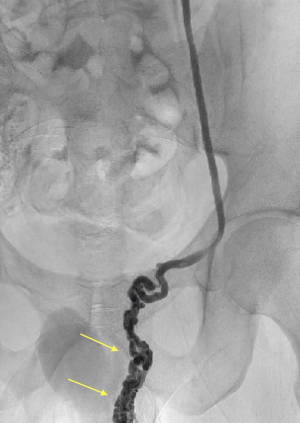Varicocele
A varicocele is the swelling in the scrotum caused by a collection of abnormally large bloods vessels (veins) in the scrotum. This is due to dilatation of the testicular vein which drains the scrotum and testicle and is a form of varicose vein. They are often described as feeling like “a bag of worms”.
A varicocele occurs in approximately 1 in 8 men and it is usually first noticed between the ages of 12 to 28. The incidence is noted to be higher in infertile couples, often up to 30%.
They usually occur on the left hand side but can occur on both sides of the scrotum. They occur more frequently on the left side as a result of the differing anatomy of the veins from which varicoceles result on the left hand side of the body compared to the right.
Symptoms
Pain:
This is often described as a discomfort or aching sensation particularly by the end of the day when the person has been standing or sitting for a long period of time. This is thought to be due to increasing pressure in the varicocele due to increased blood pooling.
Infertility:
There is an association between infertility and varicoceles. Most men with varicoceles are not infertile. However, if one has a varicocele,then there an increased chance of infertility. Among infertile couples, the incidence of a varicocele is about 30%. It is thought that the increased blood flow around the scrotum is responsible for raising the temperature in the testicles and results in defective sperm formation.
Varicoceles may cause decreased sperm count, decreased motility of sperm, or an increase in the number of deformed sperm.
Testicular atrophy:
Another symptom of varicoceles is the shrinkage of the testicles, also known as atrophy. This may recover following treatment.
Varicocele embolization
This is a non-surgical, day case procedure which is performed by an interventional radiologist. By this procedure, the vein is blocked internally, therefore accomplishing what a urologist does surgically, but without the need for surgery in the scrotum.
Surgical treatment
This is performed by a urologist, usually under general anesthesia or sedation. Then an incision is made into the skin above the scrotum. The offending veins are identified and tied off with sutures. Recovery time is often two to three weeks. A keyhole operation is also possible using a laparoscope as is used for other common operations like gallbladder removal.
Advantages of embolization over surgery
- No surgical incision or sutures.
- As effective as surgery.
- Day case procedure with no overnight stay.
- Short recovery period of one to two days.
- Hardly any complications. Infection has not been reported.
- If a patient has varicoceles on both sides, both can be treated at the same time.
How effective is varicocele embolization?
Varicocele embolization is as effective as surgery for the treatment of varicoceles as measured by improvement in pain, semen analysis and pregnancy rates. In one study pregnancy rates were as high as 60 percent. Another study showed that sperm parameters improved in 83 percent compared to 63 percent for surgery. Patients who have had both procedures express a preference for embolization.
The above information is not all inclusive of the risks, alternatives and benefits. It is not meant to be a substitute for informed discussion between you and your doctor, but can act as a starting point for such a discussion. There are complications possible with any medical procedure. Overall, minimally invasive procedures have a lower complication rate than open surgeries.






